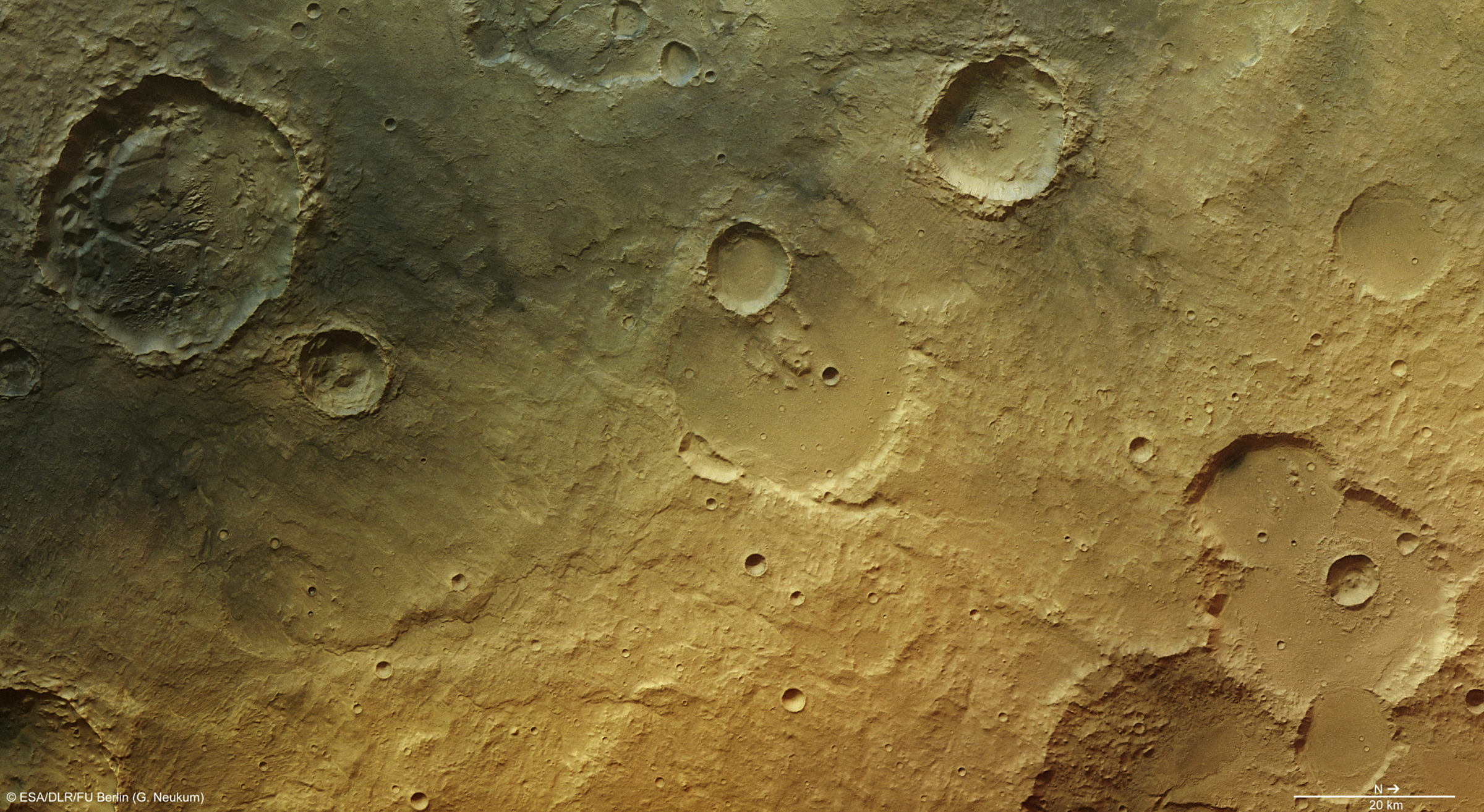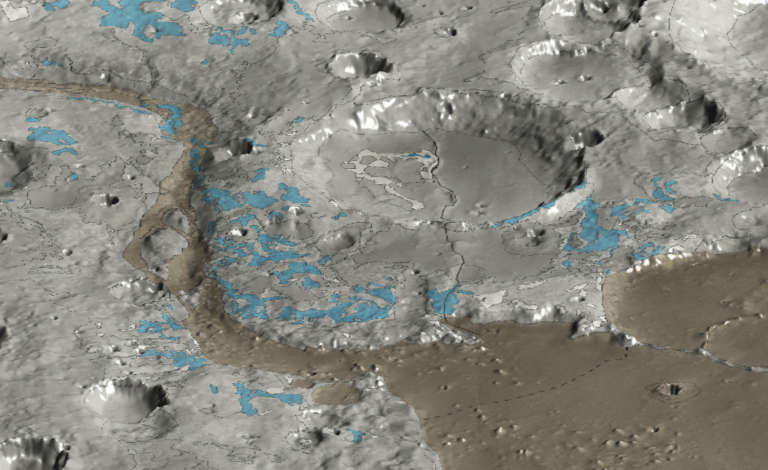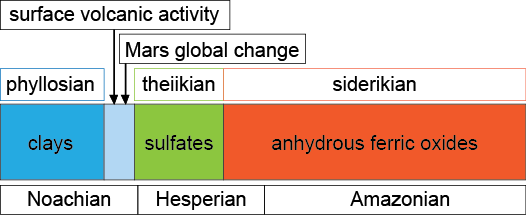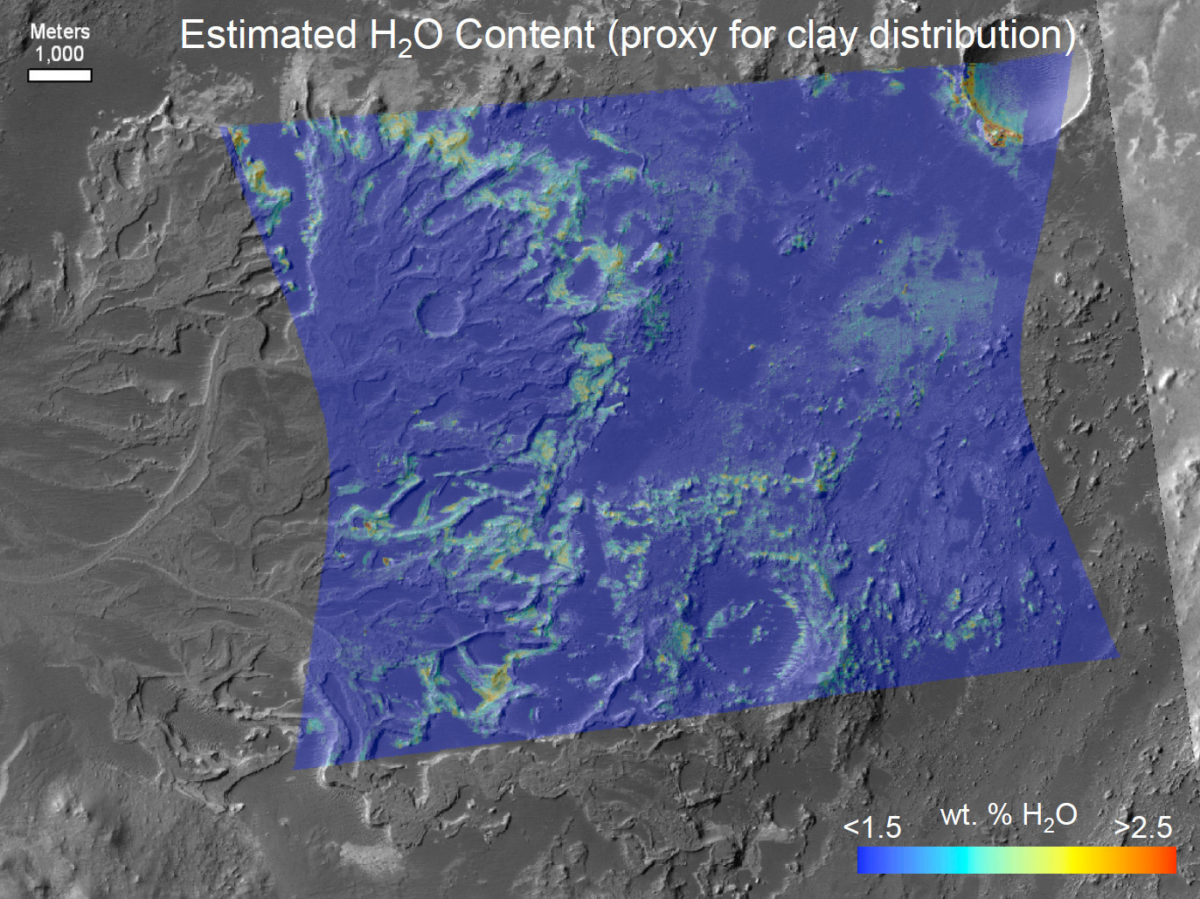Emily Lakdawalla • Dec 05, 2013
Mars' chemical history: Phyllosian, Theiikian, Siderikian, oh my
I'm returning to the deep dive into the literature that began with articles about lunar basins and then explored the geologic time scales of Earth, Moon, and Mars. The Martian geologic time scale that I described split Mars' history into three great eras: the oldest Noachian, middle Hesperian, and younger Amazonian. These were described based on crater and volcano chronology, like on the Moon.
The Moon's and Mars' time scales seem pretty similar. Mars' Noachian era is when most of Mars' impacts happened, so is roughly analogous to the Moon's Nectarian era. Mars' volcanically active Hesperian period is sort of like the Moon's Imbrian and Eratosthenian periods, when mare volcanism was happening. And both have a geologically relatively quiescent recent period, Amazonian on Mars and Copernican on the Moon.
But, upon closer examination, the Moon and Mars' geologic histories really aren't all that much alike. It was clear that there were other kinds of geology happening on Mars besides impacts and volcanism -- sedimentary geology, in particular -- but it has taken a while to understand how water has behaved on Mars in the past, and in particular, how long it ever lasted on the surface.

Most of the solar system's rocky material is made of the minerals olivine, pyroxene, and feldspar. Earth is different. On Earth, water leaves its mark not only in landforms but also in the mineralogical composition of the surface. Although olivine, pyroxene, and feldspar do occur on Earth's surface, they're just a tiny fraction of the mineralogical diversity of Earth rocks. That's because olivine, pyroxene, and feldspar are readily broken down in the presence of water into other minerals such as clays and salts. Clays are platy minerals -- the technical term for them is "phyllosilicates" -- and their crystal structures are stuffed with hydroxyl ions (water molecules with one hydrogen stripped off). Salts are ionic compounds, like chlorides, sulfates, and carbonates.
If there had been oceans on Mars under a carbon dioxide atmosphere, there should have been lots of carbonate ions dissolved in that water, so there should've been carbonate minerals left behind when the oceans vanished. Indeed, carbonate minerals have been found within some Mars meteorites. So it was a real puzzle when Mars Global Surveyor's Thermal Emission Spectrometer (TES) failed to detect the telltale signal of carbonate minerals anywhere on Mars. I remember this causing some major consternation when I was in graduate school at the end of the 1990s. Perhaps water activity on Mars had been so transient, so rare, that it had left almost no imprint on Martian minerals, except in very rare locations, like Meridiani Planum, where TES saw the mineral hematite. And yet researchers including my own advisor were publishing articles about putative shorelines encircling northern oceans. They couldn't both be right.
The last decade has seen a real revolution in the richness of the story that we can tell about Mars. The new story has come from a new capability to observe and map the distributions of specific minerals wherever they are visible on Mars' surface. That new capability arrived at Mars as spectrometers on two Mars orbiters: Observatoire pour la Minéralogie, L’Eau, les Glaces et l’Activitié (OMEGA) on Mars Express, which arrived at the end of 2003, and Compact Reconnaissance Imaging Spectrometer for Mars (CRISM) on Mars Reconnaissance Orbiter, which arrived in early 2006.
Both OMEGA and CRISM are near-infrared imaging spectrometers. A spectrometer can be a powerful tool for the detection of minerals. By splitting incoming light into hundreds of little wavelength slices, they can look for variations in color that can be used to diagnose the presence of certain minerals. The following quote may be a little too technical for some, but I thought it was a really nice explanation of the specifics of what spectrometers do, courtesy of Bethany Ehlmann and Christopher Edwards. (If you don't understand this, fear not, just skip it and keep reading.)
In thermal infrared spectroscopy (TIR, defined here as 5-50μm), vibrations in the molecular lattice lead to distinctive minima, diagnostic of composition, in electromagnetic radiation thermally emitted from the surface. These include variations in silica polymerization that determine the position and shape of the Si-O stretch (~10 μm) and absorptions by structural components of sulfates, carbonates, iron oxides, and aluminosilicates. Similarly, in the visible and near-infrared wavelengths (VNIR, defined here as 0.4-5 μm), sunlight reflected from the surface of Mars is diminished at certain wavelengths by absorptions that are diagnostic of the surface composition. Absorption of energy by electrons of transition metal elements, most commonly iron, produces distinctive spectral features from 0.4-2 μm for olivines, pyroxenes, Fe-bearing glasses, and Fe-oxides such as hematite and goethite. Vibrational absorptions from 1-5 μm are overtones of those in the TIR and provide the ability to identify minerals with OH, H2O or CO3.
OMEGA and CRISM were not the first spectrometers to be sent to Mars. But they had sharper vision than their predecessors, the Thermal Emission Spectrometer (TES) on Mars Global Surveyor and the Thermal Emission Imaging System (THEMIS) on Mars Odyssey. Plus, their near-infrared vision proved capable of detecting some crucial minerals that the thermal-infrared instruments couldn't.
There are two key papers that describe the new view of Mars' history based on OMEGA and CRISM results. The OMEGA one, by Jean-Pierre Bibring and coauthors, was published in Science in April, 2006: "Global Mineralogical and Aqueous Mars History Derived from OMEGA/Mars Express Data." Since that link is subscription-only, here's the ESA press release about the article: "Mars Express's OMEGA Uncovers Possible Sites for Life." The CRISM one, by Scott Murchie and coauthors, was published in the Journal of Geophysical Research in February 2009: "A synthesis of Martian aqueous mineralogy after 1 Mars year of observations from the Mars Reconnaissance Orbiter." There wasn't a JPL press release associated with that one, probably because its publication came just after they issued a press release a CRISM-related publication in Science, in December 2008, about the detection (finally!) of carbonates. But carbonates were only a small piece of the story.
OMEGA

The brief OMEGA paper laid out a new paradigm for understanding the history of Mars, based upon their first year of operations. They had mapped 90% of the surface at low resolution (1.5 to 5 kilometers per pixel), and 5% percent of it at higher, half-kilometer resolution. They made the following observations:
- Olivine and pyroxene are exposed across Mars, mainly in older terrains. (This implies little weathering of those surfaces over time -- score a point for a drier Mars.)
- But the northern lowlands show no spectral evidence for olivine and pyroxene, meaning their minerals are chemically altered. (Score a point for a wetter Mars.)
- Mars' ubiquitous bright, red dust does not show any trace of the presence of water in its mineral structure; "liquid water is not responsible for Mars being red." (Dry Mars.)
- OMEGA did detect two kinds of hydrated minerals: phyllosilicates (clays) and sulfates, but only in a few locations, including Nili Fossae and Mawrth Vallis. (A little bit wet?)
- All phyllosilicate locations are ancient, Noachian in age, and were buried rocks that have been exposed by erosion. (Wet Mars -- but only in ancient times.)
- Curiously, OMEGA did not detect hydrated minerals in places that seem to have needed water to form, like the lobate ejecta of rampart craters, or the floors or deposits from outflow channels. (That one's just confusing. Wet events that were too sudden to alter minerals?)
- Sulfates -- which had previously been reported by both Spirit and Opportunity -- were detected in Meridiani, in Valles Marineris, and in the dark dunes of the north polar cap. (Wet, but requires very acid water.)
- OMEGA detected no carbonates. (Where are they hiding??) They suggested CRISM, with its higher resolution, might be able to find some.
The formation of phyllosilicates requires neutral or alkaline pH, but could have happened either at the surface or through the action of groundwater at depth. It doesn't require a warm Mars, just a wet one. Sulfates, on the other hand, require a considerable amount of water at the surface, because they pretty much form by evaporation, and it has to be very acid water.
The continued absence of evidence for carbonates was a vexing puzzle. They proposed four possible explanations for why carbonates are not ubiquitous on Mars:
- The watery era was so short that there wasn't time for carbonates to form;
- The detected clay minerals formed mostly under the surface; liquid water never interacted with a carbon-dioxide-rich atmosphere;
- Carbonates formed, but were later eliminated by acidic weathering; or
- Mars never had a dense carbon dioxide atmosphere.
Then they punted to CRISM, expressing hope that the future spectrometer could detect carbonates, and in so doing, differentiate among these hypotheses.
Bibring and coauthors considered the OMEGA data and then proposed that we must be seeing evidence for a transition in global chemistry on Mars. In Noachian times, conditions prevailed that favored the formation of clay minerals, either at or below the surface. After that, in the early Hesperian, massive amounts of volcanism belched sulfur gases and water into the air, which would react to make sulfuric acid and rain into acidic bodies of water. Finally, in a third era that includes the present time, liquid water was unimportant to Martian mineralogy, as evidenced in the utter lack of water in modern Mars dust and in the unaltered exposures of minerals like olivine and pyroxene. Bibring named these three eras the phyllosian, theiikian, and siderikian. They did not quite line up with the preexisting chronology of Noachian, Hesperian, and Amazonian:

I have to make a confession: when I first saw the substance of this paper presented at a scientific meeting, I was dubious of how, based upon very early work with a new data set of considerable complexity, they could make this (to me) oversimplified generalization about the geologic history of a whole planet. And I was annoyed by the coining of three new words to name Martian ages when we had three perfectly good existing words to use to describe sequential ages on Mars. Stuff that gets published in Science is often sensational and often turns out to be wrong, at least in part, once people have taken more time to analyze a data set more thoroughly. Mars' real history couldn't possibly turn out to be so unidirectional. Could it? The arrival of CRISM at Mars would provide a crucial test of the OMEGA hypothesis.
CRISM

As promised, CRISM achieved much higher-resolution observations than OMEGA did, and discovered new kinds of minerals in new geologic settings. Murchie and coauthors summarized previous TES and OMEGA work as finding four (maybe five) distinct types of hydrated minerals in limited exposures on Mars:
- hematite-bearing sulfates in Meridiani, where Opportunity later landed;
- hematite-bearing sulfates in Valles Marineris canyons including Candor, Melas, Juventae, Tithonium, and Eos chasmata, which might or might not be the same stuff as at Meridiani;
- gypsum-bearing sand dunes near the north pole;
- layered phyllosilicates exposed beneath unaltered rocks at Nili and Mawrth and in some Valles Marineris walls; and
- deep phyllosilicates exposed in highland crater rims and central peaks.
CRISM confirmed this list, and added five more types of occurrences of hydrated minerals, visible thanks to CRISM's much higher resolution, which revealed tiny exposures of minerals all over the ancient southern highlands. They were ancient minerals exposed with the help of impacts, little spots of color visible in the walls, peaks, and ejecta blankets of craters. They included:
- phyllosilicates in fans and deltas in between highland craters, most commonly in the lowermost layers of those deltas, sometimes associated with chlorides, found throughout the southern highlands;
- phyllosilicates in fans and deltas inside highland craters such as Holden, Eberswalde, Jezero, and Terby;
- interbedded phyllosilicates and sulfates making "bathtub rings" inside a few craters in Terra Sirenum;
- light-toned hydrated silica layers -- that is, opal -- of Hesperian or possibly even Amazonian age, in plains surrounding Valles Marineris; and
- carbonates (finally!!) in Noachian age terrain, primarily surrounding Isidis.
Taken together, these discoveries of many different kinds of hydrated minerals on Mars mean that there were many different kinds of watery environments on Mars over its history. What do the CRISM results mean for the OMEGA paradigm? The paper states:
The diversity of aqueous deposits as known after new discoveries by MRO still falls neatly in Bibring et al.’s [2006] framework. With little exception, phyllosilicate- and carbonate-bearing deposits fall stratigraphically into the early to late Noachian phyllosian environment. The sulfate- and silica-bearing deposits that suggest acidic conditions correspond to the late Noachian and Hesperian theiikian environment.
The CRISM paper goes on to say that there are two places -- the interbedded sulfates and clays in the highland craters, and the exposures of carbonates around Isidis -- where the story must be slightly more complicated; but on the whole, the CRISM results tend to support the conclusions made from OMEGA data.
Woohoo! Are we finally getting a handle on the history of water on Mars? It's wonderful to see later work confirm previous work. I have to take back my skepticism of the earlier OMEGA paper, and I may even have to start using those three new words. Let's try them on again: phyllosian, theiikian, siderikian.
However, in the introduction to their paper, the CRISM team pointed out that orbital data can only take you so far.
Orbital reconnaissance can identify an aqueous deposit and support multiple working hypotheses for its origin, but landed investigation has proven necessary to distinguish among these hypotheses and to decipher the environment that it records. Landed investigation also shows that orbital reconnaissance provides a 'lower limit' on the mineralogic diversity at a given site, with much of that record not being detectable from orbit because of dust cover or limitations in spatial resolution.
The diversity of watery environments on past Mars provided many kinds of places in which life could possibly have existed. If we want to understand the conditions that might have favored life, we want to explore as many different kinds of environments as possible. The earliest, phyllosian era is arguably most similar to Earth, but Earthly life does manage to persist in extremely acid environments like those that persisted during the theiikian era. Both Opportunity and Spirit explored sulfate-rich rocks from the theiikian era, so Curiosity clearly needed to be sent to more ancient rocks from the phyllosian era.
And that's what they did. And, while they were busy building Curiosity, they also drove Opportunity across tens of kilometers of theiikian-age rocks to reach the rim of an ancient crater, Endeavour, where clay minerals were exposed. We now have two Martian rovers exploring rocks from Mars' most ancient, wettest era, and we couldn't have done that without Mars Express OMEGA and Mars Reconnaissance Orbiter's CRISM.


The Time is Now.
As a Planetary Defender, you’re part of our mission to decrease the risk of Earth being hit by an asteroid or comet.
Donate Today

 Explore Worlds
Explore Worlds Find Life
Find Life Defend Earth
Defend Earth

